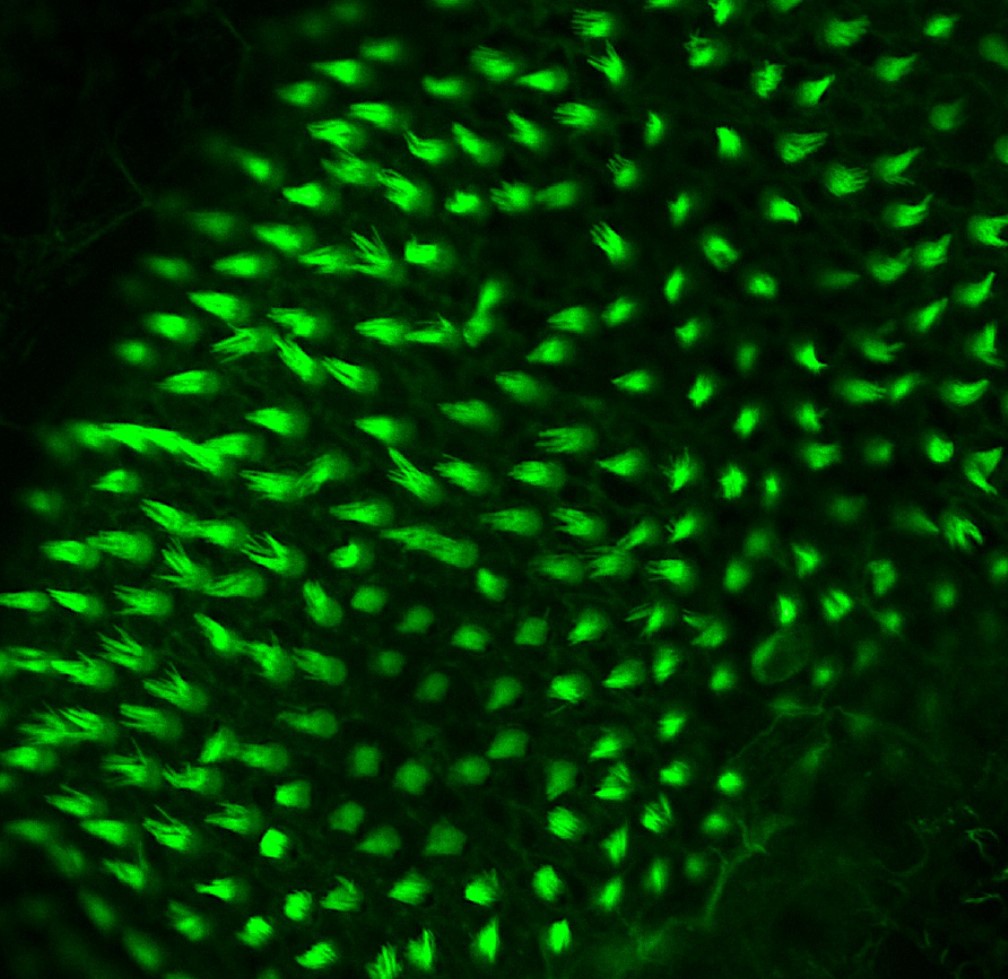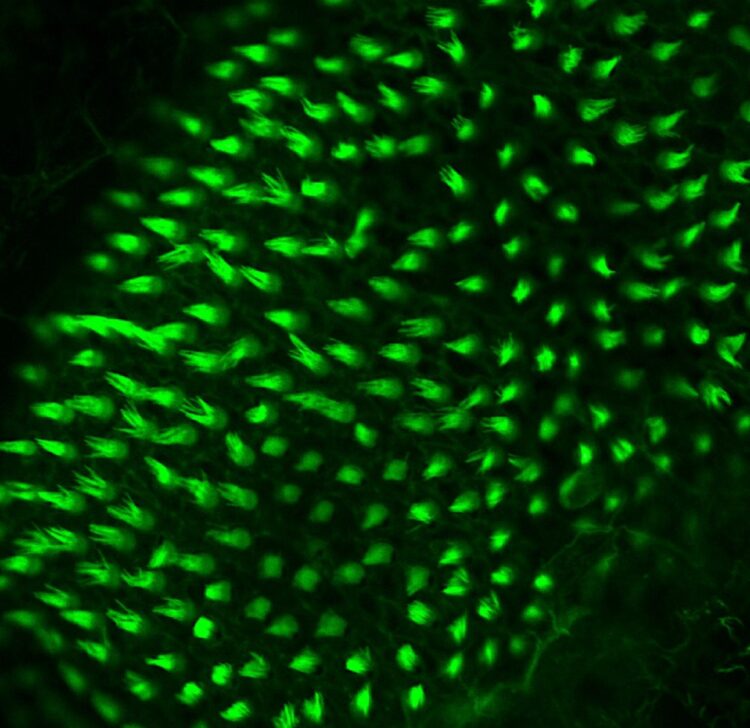National Institutes of Health researchers have discovered a specific network of proteins that is necessary to restore hearing in zebrafish through cell regeneration. The study, led by investigators at the National Human Genome Research Institute (NHGRI), may inform the development of treatments for hearing loss in humans. The findings were published in Cell Genomics.

Credit: Erin Jimenez, Ph.D.
National Institutes of Health researchers have discovered a specific network of proteins that is necessary to restore hearing in zebrafish through cell regeneration. The study, led by investigators at the National Human Genome Research Institute (NHGRI), may inform the development of treatments for hearing loss in humans. The findings were published in Cell Genomics.
Although hair cell loss cannot be replaced in humans, many animals, including zebrafish, can restore hearing after injury through the regeneration of hair cells. The regenerative properties of zebrafish hair cells prompted researchers to use this animal to understand some fundamental properties of regeneration.
Hearing loss affects around 37.5 million Americans, and most cases come from the loss of hearing receptors known as “hair cells” in the inner ear. Bristles that stick out of these microscopic hair cells move and bend when sound travels into our ears, resulting in electric signals sent through nerves and into our brains that allow us to process sound.
Humans and zebrafish are visually quite different, but at a genomic level, they share more than 70% of their genes. This genomic similarity offers the potential for researchers to understand the biology of cell regeneration in zebrafish before translating the findings to humans.
Erin Jimenez, Ph.D., a postdoctoral fellow in the laboratory of Shawn Burgess, Ph.D., senior investigator in the National Human Genome Research Institute’s (NHGRI) Translational and Functional Genomics Branch, led the study in collaboration with researchers Ivan Ovcharenko, Ph.D., and Wei Song, Ph.D., at the National Library of Medicine’s National Center for Biotechnology Information.
“Humans and other mammals are born with a set number of hair cells that are slowly lost through aging and trauma. However some animals, such as zebrafish, can regenerate hair cells and recover hearing after injury,” said Burgess. “How and why regeneration happens in these animals remain a mystery that many scientists would like to unravel.”
Using a combination of genomic techniques and computational-based machine learning, Jimenez and her collaborators found that hair cell regeneration in zebrafish relied on a network of proteins that can switch genes on and off, known as transcription factors. To properly identify which transcription factors were at play, the researchers first had to look at the enhancer sequences within the zebrafish genome.
If transcription factors are thought of as the keys that turn a car on and off, enhancer sequences are the car’s ignition switch. Both parts need to interact to make a car run, just like how transcription factors need to bind to specific enhancer sequences to express a gene.
The researchers used new genomic techniques called single-cell RNA sequencing and single-cell assay for transposase-accessible chromatin using sequencing to identify the enhancer sequences and their corresponding transcription factors that play a role in hair cell regeneration.
“Our study identified two families of transcription factors that work together to activate hair cell regeneration in zebrafish, called Sox and Six transcription factors,” said Jimenez.
First, the Sox transcription factors initiate the regeneration response in surrounding cells, called support cells. Next, the Sox and Six transcription factors cooperate to turn those support cells into hair cells.
When hair cells die in zebrafish, nearby support cells start replicating. These support cells are like stem cells because of their ability to become other cell types. Researchers had identified some of the factors that convert support cells into hair cells, but what was not understood is how and where the genes encoding those factors turn on and are coordinated with other unknown factors.
“We have identified a unique combination of transcription factors that trigger regeneration in zebrafish. Further down the line, this group of zebrafish transcription factors might become a biological target that may lead to the development of novel therapy to treat hearing loss in humans,” Jimenez said.
Reference: Erin Jimenez, Claire C. Slevin, Wei Song, Zelin Chen, Stephen C. Frederickson, Derek Gildea, Weiwei Wu, Abdel G. Elkahloun, Ivan Ovcharenko, Shawn M. Burgess. A regulatory network of Sox and Six transcription factors initiate a cell fate transformation during hearing regeneration in adult zebrafish. Cell Genomics, 2022. https://doi.org/10.1016/j.xgen.2022.100170.
##
The National Human Genome Research Institute (NHGRI) is one of the 27 institutes and centers at the NIH, an agency of the Department of Health and Human Services. The NHGRI Division of Intramural Research develops and implements technology to understand, diagnose and treat genomic and genetic diseases. Additional information about NHGRI can be found at: https://www.genome.gov/.
The National Institutes of Health (NIH) is the nation’s medical research agency, includes 27 institutes and centers and is a component of the U.S. Department of Health and Human Services. NIH is the primary federal agency conducting and supporting basic, clinical and translational medical research, and is investigating the causes, treatments and cures for both common and rare diseases. For more information about NIH and its programs, visit https://www.nih.gov/.
DOI
10.1016/j.xgen.2022.100170
Method of Research
Experimental study
Subject of Research
Animals
Article Title
A regulatory network of Sox and Six transcription factors initiate a cell fate transformation during hearing regeneration in adult zebrafish
Article Publication Date
14-Sep-2022





